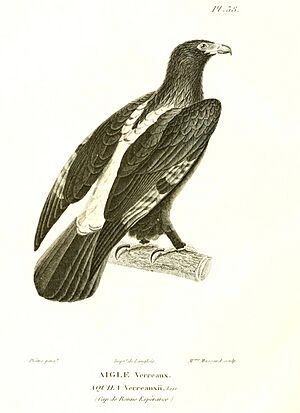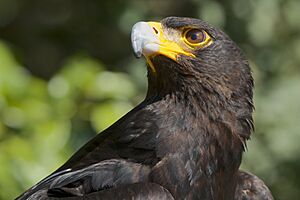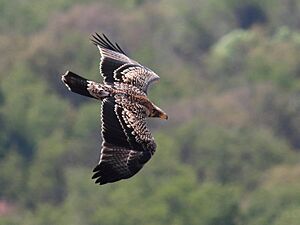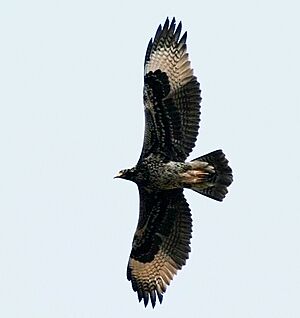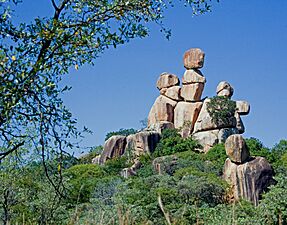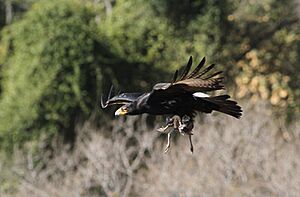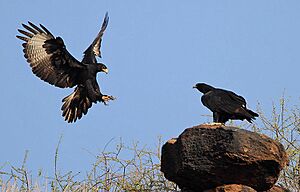Verreaux's eagle facts for kids
Quick facts for kids Verreaux's eagle |
|
|---|---|
 |
|
| At the Walter Sisulu National Botanical Garden in Roodepoort, South Africa | |
| Conservation status | |
| Scientific classification | |
| Genus: |
Aquila
|
| Species: |
verreauxii
|
 |
|
| range of Verreaux's eagle | |
The Verreaux's eagle (Aquila verreauxii) is a large bird of prey. It lives mostly in Africa. People also call it the black eagle, especially in southern Africa. But don't confuse it with the black eagle from Asia! This eagle prefers to live in rocky, mountainous areas. You can find it in southern and eastern Africa. It also lives in small parts of Chad, Mali, Niger, and the Middle East.
Verreaux's eagle is very special. Its life revolves around hunting rock hyraxes. These are small, furry mammals. If there aren't enough hyraxes, the eagles can hunt other animals. They might eat small antelopes, gamebirds, hares, or monkeys. Even though it's a picky eater, the Verreaux's eagle is doing well. One group in Matobo National Park in Zimbabwe is very famous. Scientists have studied these eagles since the 1950s. Like all eagles, this bird is a raptor. It belongs to the family Accipitridae.
Contents
Understanding Verreaux's Eagle: Taxonomy
A French scientist named René Primevère Lesson first described this eagle. He wrote about it in 1830. He named it Aquila Verreauxii. The name honors Jules Verreaux. He was a French naturalist who visited southern Africa. He collected the first example of this eagle for science.
Verreaux's eagle is part of a group called "booted eagles". This means they have feathers all the way down their legs. Most other eagles have bare legs. The Aquila group of eagles lives on every continent except South America and Antarctica. Scientists used to think there were 20 species in this group. But new research has changed some ideas.
Recent genetic studies show that Verreaux's eagle is related to some other eagles. Its closest relatives are the Bonelli's eagle and the African hawk-eagle. It is also related to the golden eagle. Other relatives include the wedge-tailed eagle and Gurney's eagle. This research helps us understand how these amazing birds are connected.
What Does a Verreaux's Eagle Look Like?
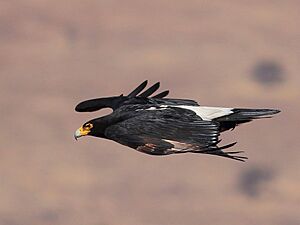
The Verreaux's eagle is a very large bird. It can be from 75 to 96 centimeters (about 30 to 38 inches) long. This makes it one of the longest eagles in the world. Males usually weigh between 3 and 4.2 kilograms (6.6 to 9.3 pounds). Females are bigger, weighing from 3.1 to 7 kilograms (6.8 to 15.4 pounds). Its average weight is about 4.19 kilograms (9.2 pounds).
It has a wingspan of 1.81 to 2.3 meters (about 6 to 7.5 feet). Adult males and females look almost the same. The only difference is the female's slightly larger size.
Adult Verreaux's eagles are mostly jet-black. Their bill is grey, but their cere (the fleshy part above the bill), eye-ring, and "eye-brows" are bright yellow. When they fly, you can see a white V-shaped patch on their back and rump. They also have white patches on their wing quills. These look like "windows" when they fly. Their legs are completely covered in feathers.
Young eagles look very different. They are dark brown. Young birds have a bright golden crown and a reddish-brown neck. Their throat is dark, and their chest is brown. The rest of their underside is brown with some creamy patches. Their wings have white mottling. Young eagles have dark brown eyes and yellowish feet. They slowly turn black as they get older. They look like adults by about 5 to 6 years old.
It's easy to spot a Verreaux's eagle. No other black raptor in its home range is as big or has its white markings. The golden eagle is similar in size. But the golden eagle is mostly brown, not black. Young golden eagles have some white on their wings, but not as much as the Verreaux's. The Verreaux's eagle also has unique paddle-shaped wings. It soars with its wings held in a V-shape.
What Sounds Do They Make?
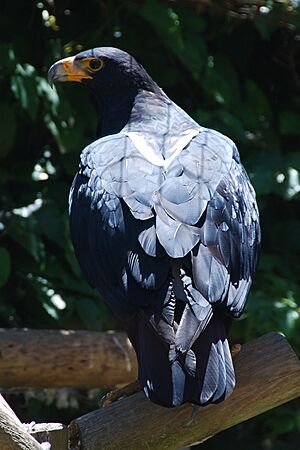
This eagle is usually quiet. But it can make loud calls. They make "whaeee-whaeee" or "keeooo-keeooo" sounds to talk to each other. They also make screams, barks, and yelps if they see a predator. Young eagles make soft chirps at first. Later, they cluck like the adults.
Where Do Verreaux's Eagles Live?
Verreaux's eagles need a special kind of home. They live in dry, rocky places called kopjes. These can be rocky hills, high mountains, or cliffs. These areas are often surrounded by savanna or desert. They like dry places with little rain.
They live at high altitudes in Ethiopia and East Africa, up to 4,000 meters (about 13,000 feet) above sea level. You can find them in Sudan, Eritrea, Somalia, Ethiopia, Kenya, and Tanzania.
The main home of the Verreaux's eagle is in southeastern Africa. They live in mountains in Malawi, Zambia, Zimbabwe, Mozambique, Eswatini, Lesotho, and South Africa. They are also found in Botswana, Namibia, and Angola. Sometimes, they are seen in other parts of Africa like Mali and Niger. They are also rare breeders in the Middle East, in places like Lebanon, Israel, and Oman.
What Do Verreaux's Eagles Eat?
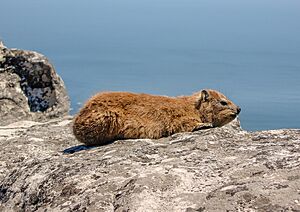
Verreaux's eagles mostly eat two types of hyraxes: the Cape hyrax and the yellow-spotted rock hyrax. These two animals make up more than half, and often over 90%, of their diet. Very few other birds of prey are so specialized in hunting just one type of animal.
In Matobo National Park in Zimbabwe, hyraxes were 98.1% of their diet from 1957 to 1990. In Serengeti National Park in Tanzania, hyraxes were 99.1% of their food. A pair of eagles with young can eat about 400 hyraxes in a year. The areas where Verreaux's eagles live match exactly where these two hyrax species are found. They don't hunt tree hyraxes.
Verreaux's eagles often hunt by flying low. They surprise hyraxes with a fast, twisting dive. Hyraxes are very careful because many animals hunt them. Eagles sometimes hunt from a perch, but not often. Eagles have been seen hunting together. One eagle distracts the hyrax, and the other attacks from behind. They usually kill prey on the ground. An eagle needs about 350 grams (12 ounces) of food each day.
Yellow-spotted rock hyraxes weigh from 1 to 3.63 kilograms (2.2 to 8 pounds). Cape hyraxes are bigger, weighing from 1.8 to 5.5 kilograms (4 to 12.1 pounds). Cape hyraxes can be as big as the eagles themselves! Yellow-spotted hyraxes are often hunted more because they are smaller. Eagles often choose adult hyraxes. Young male Cape hyraxes are also easy prey when they leave their families.
Because Cape hyraxes are so heavy, eagles sometimes eat them where they kill them. Or they might cut off the head and bring the body to the nest. The foot of a Verreaux's eagle is very large, even bigger than a human hand. This helps them catch the wide-backed hyraxes.
Other Foods They Eat
Verreaux's eagles can eat many different animals. But they only do this if there aren't enough hyraxes. This usually happens in areas where hyrax numbers have dropped. Or in places where the eagles live outside rocky areas, like savannas. In these "poor food areas," about 80% of their prey are mammals.
Scientists have recorded Verreaux's eagles eating at least 100 different prey species. These include small antelopes, hares, rabbits, meerkats, mongooses, monkeys, and even lambs or goat kids. They also eat birds like francolins, guineafowl, waterfowl, and pigeons. They can even hunt large birds like Denham's bustard. Sometimes, they eat tortoises, snakes, lizards, and even termites.
In South Africa, their favorite foods are Cape hyrax, Smith's red rock hare, and meerkat. They also eat mountain reedbuck, goats, and sheep. In the Walter Sisulu National Botanical Garden, after hyrax numbers went down, they started eating more helmeted guineafowl and francolins. They rarely eat dead animals. Unlike golden eagles, Verreaux's eagles usually don't eat dead lambs.
They can even hunt large mammals. They have been seen hunting adult klipspringers. One eagle brought a 12-kilogram (26-pound) klipspringer lamb to its nest. They have also killed a 15-kilogram (33-pound) mountain reedbuck lamb. The smallest mammal they eat is a tiny 97.6-gram (3.4-ounce) Cape gerbil.
Who Do They Compete With?

Verreaux's eagles are the best hyrax hunters. But other animals also hunt hyraxes. This means they can compete for food. Other large African eagles, like the crowned eagle and martial eagle, also eat hyraxes. But these eagles live in different places or hunt in different ways. Crowned eagles live in forests and hunt from perches. Martial eagles live in savannas and hunt from high in the sky.
Sometimes, Verreaux's eagles fight with martial eagles. Even though martial eagles are bigger, a Verreaux's eagle once stole a hyrax from one. They have also stolen food from lammergeiers. Verreaux's eagles sometimes hunt other large raptors, like vultures. This usually happens when they are defending their nests.
In Ethiopia, Verreaux's eagles live near their close relatives, the golden eagles. They defend their territories from each other. Golden eagles often chase Verreaux's eagles away. But they don't harm each other's breeding. This is because golden eagles prefer to eat hares, while Verreaux's eagles prefer hyraxes.
Other animals that hunt hyraxes include caracals, leopards, jackals, African rock pythons, and large owls. Young hyraxes can be eaten by mongooses or venomous snakes. Eagles are very careful when hunting because of all these competitors. They have even been seen dropping sticks on animals that get too close to their nests. This is a rare behavior for birds of prey.
Verreaux's Eagle Behavior
Their Home and Movements
A Verreaux's eagle pair usually has a home range of about 10.9 square kilometers (4.2 square miles). In the Matobo National Park in Zimbabwe, there are many eagles. Here, one pair lives in about every 10.3 square kilometers (4 square miles). In other places, they might need more space. Their territories stay the same year after year. This is common for long-lived birds in warm places with steady food.
Eagle numbers don't change much, even if hyrax numbers go up or down. If there are very few hyraxes, eagles might leave or find other food. This usually only happens during droughts.
Adult Verreaux's eagles usually stay in their home range their whole lives. Young eagles, however, fly to new areas once they leave their parents.
Verreaux's eagles often fly in special ways to show off their territory. This happens when another eagle flies into their area. Or if they are worried about their nest. The male eagle flies up and down in waves. Then he dives down very fast, sometimes for 305 meters (1,000 feet)! He then flies back up, sometimes doing flips or rolls. Pairs of eagles also fly in circles or figure-eights over their home. One bird might flip over and show its claws. These displays are usually to defend their territory. Sometimes, eagles fight in the air, locking talons and falling.
Reproduction and Life Cycle
In Zimbabwe, about 60 pairs of eagles might nest in 620 square kilometers (240 square miles). This means one pair per 10.3 square kilometers (4 square miles). In East Africa, one pair nests every 25 square kilometers (9.6 square miles).
Verreaux's eagles build 1 to 3 nests, or sometimes none, in a year. In the Matobo National Park, pairs build about 1.4 nests on average. Their nests are usually on cliffs, in a small cave or on a ledge. The nest is often marked by white droppings. Very rarely, they might nest in trees or even on electric pylons.
A new nest takes up to four months to build. Both the male and female help build it, but the female usually leads. Nests are wide but not very deep. They are made of green branches and lined with green leaves. An old nest can be very deep, up to 4.1 meters (13.5 feet).
Predators like African rock pythons, baboons, and caracals might attack young in the nest. But this is rare. Most nests are hard to reach. Also, the parent eagles bravely defend their young. Eagles have even been seen dropping sticks on animals that threaten their nest.
Eagles lay eggs from November to August in Sudan and Arabia. In Ethiopia and Somalia, it's from October to May. In East Africa, they lay eggs all year, but mostly from June to December. In southern Africa, it's from April to November. The male eagle often brings food to the female before she lays eggs. He also brings most of the food during incubation.
They usually lay two eggs, but sometimes one or three. The eggs are white, sometimes with a blue tint or reddish-brown marks. They are about 71 to 83.4 millimeters (2.8 to 3.3 inches) long. Eggs are laid about three days apart. Both parents incubate, but the female does most of it. Incubation lasts 43 to 47 days.
The eggs hatch about 2 to 3 days apart. One egg is sometimes infertile. The second egg is usually about 10% smaller. The older chick often kills the younger one. This happens in over 90% of nests. This behavior is common in eagles. The second chick acts as a backup in case the first one dies. It also helps the parents by sharing the workload. Very rarely, both young eagles survive.
The parents don't feed the hatchling for the first 36 hours. After that, they feed it regularly. The young eagle is covered in feathers by about 60 days. The eaglet flies out of the nest at 95–99 days old. This is about 35 days longer than golden eagles. The young eagle returns to the nest for the first two weeks after its first flight. The male brings more food at first, then the female does. After about 45–50 days, the parents catch food for themselves, not for the young. Family groups stay together for up to 6 months after the young leave the nest. The young eagle gets stronger and goes hunting with its parents.
Verreaux's eagles usually breed every year. Sometimes, they breed every other year.
How Are Verreaux's Eagle Populations Doing?
About 40–50% of Verreaux's eagle nests are successful each year. They are more successful when there are many hyraxes. If food is scarce, they might not even try to breed. They also breed less often in wetter years.
The average lifespan of a Verreaux's eagle is about 16 years. There are tens of thousands of these eagles in total. In northeastern South Africa, there are about 240 breeding pairs. The western Cape region might have over 2,000 pairs.
Verreaux's eagles live in rocky areas. These places are usually safe from human development. Unlike other large African eagles, they don't eat much dead meat. This means they are less likely to be poisoned by bait left for jackals. However, some people still shoot them. They wrongly believe the eagles are a threat to their small farm animals.
The biggest problem for these eagles is when people hunt hyraxes. If hyrax numbers go down, the eagles have to find other food. Or their nesting attempts might fail. In the Walter Sisulu National Botanical Garden in South Africa, hyrax numbers have dropped. But the eagles there are still breeding well. Even with many people around, the eagles continue to nest. However, in South Africa, the total number of pairs went down from 78 in 1980 to 27 in 1988. Scientists are thinking about feeding the eagles in the Sisulu Botanical Garden to help them. This would ensure they have enough food to keep breeding.



